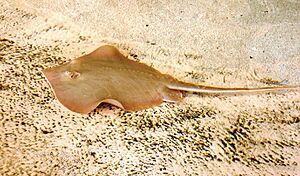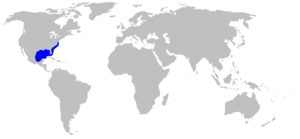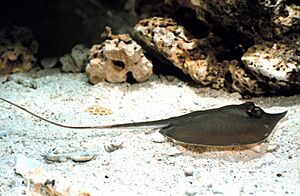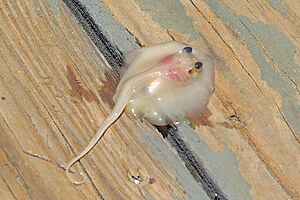Atlantic stingray facts for kids
Quick facts for kids Atlantic stingray |
|
|---|---|
 |
|
| Conservation status | |
| Scientific classification | |
| Genus: |
Hypanus
|
| Species: |
sabinus
|
 |
|
| Range of the Atlantic stingray | |
| Synonyms | |
|
|
The Atlantic stingray (Hypanus sabinus) is a type of stingray found along the Atlantic coast of North America. You can spot them from Chesapeake Bay all the way down to Mexico. What makes them special is that they can live in different kinds of water, including brackish (a mix of fresh and salt) and even freshwater! They are known for their longer snout compared to other stingrays in the area. These stingrays are not usually caught for food, but sometimes they are sold for aquariums.
Contents
About the Atlantic Stingray's Name
The Atlantic stingray was first described by a French naturalist named Charles Alexandre Lesueur in 1824. He gave it the scientific name Trygon sabina. He studied a male stingray that was collected in Florida. Over time, scientists have changed its scientific name a few times, but now it is officially known as Hypanus sabinus.
Where Atlantic Stingrays Live
You can find the Atlantic stingray in the western Atlantic Ocean. Their home stretches from Chesapeake Bay south to Florida and the Gulf of Mexico, reaching as far as Campeche, Mexico. What's really cool about these stingrays is that they can live in water with different amounts of salt. This means they can be found in estuaries (where rivers meet the sea) and even in freshwater lakes and rivers. For example, they live in the Mississippi River and the St. Johns River in Florida. The stingrays in the St. Johns River are the only group of stingrays in North America that live permanently in freshwater.
These stingrays like shallow coastal waters where the bottom is sandy or muddy. They prefer warmer water, usually above 59°F (15°C), and can handle temperatures over 86°F (30°C). To stay warm, they move around with the seasons. In the northern areas like Chesapeake Bay, they are only there in the summer and fall. In other places, they move to deeper water during winter. When they are close to shore, they usually stay at depths of about 6 to 20 feet (2-6 meters). When they move offshore, they might go as deep as 82 feet (25 meters).
What Atlantic Stingrays Look Like
The Atlantic stingray is one of the smaller stingray species. It can grow up to about 2 feet (61 cm) long and weigh up to 11 pounds (4.9 kg). Their body, called a disk, is shaped like a spade, a bit wider than it is long, with rounded corners. They have a snout that is quite long. Inside their mouth, they have three small bumps called papillae. Their teeth are usually round and flat. However, during mating season, the teeth of male stingrays change to become long and sharp. This helps them hold onto the female during mating.
Their tail is long and thin, like a whip. It has a jagged spine that is about a quarter of the width of their body disk. This spine is replaced every year between June and October. The tail also has folds of skin on the top and bottom. As Atlantic stingrays get older and bigger, they can grow small bumps or thorns along the middle of their back, reaching to where the tail spine begins. Some older females also get these bumps around their eyes. Their color is usually brown or yellowish-brown on top, getting lighter towards the edges. Their underside is white or light gray. The tail folds are yellowish. In larger stingrays, the tail might have gray spots near the base and be completely dark at the tip.
Life and Habits of the Atlantic Stingray
Atlantic stingrays mostly eat small animals that live on the ocean floor, like clams, tube anemones, small shrimp-like creatures, and worms. They use special sensors, called ampullae of Lorenzini, to find their food by detecting tiny electrical signals. When they are eating, they often face the current so that the water washes away the sand, making it easier to find their meal.
Many animals hunt Atlantic stingrays. Large sharks, like the tiger shark and the bull shark, are common predators. In freshwater areas, American alligators might also prey on them. A tiny parasite called Argulus, which is a type of fish louse, sometimes feeds on the skin of freshwater Atlantic stingrays.
Even though Atlantic stingrays live in freshwater, their bodies are still built to handle different salt levels. They haven't developed the super-specialized ways of handling salt that true freshwater stingrays have. This might be because they only started living in freshwater relatively recently (less than a million years ago). Their blood has much less urea (a waste product) and other salts compared to stingrays living in the ocean. Because of this difference, water tends to flow into their bodies. To deal with this, they produce a lot of very dilute urine—about 10 times more than stingrays in saltwater!
Like other stingrays, the Atlantic stingray gives birth to live young, rather than laying eggs. Both marine and freshwater populations in Florida mate once a year, from September or October to April. The female releases her eggs in late March or early April. During courtship, the male follows the female and bites her body and fins. He will hold onto her pectoral fin to help with mating. The baby stingrays grow inside the mother, first getting food from a yolk sac. After about 60 days, they are nourished by a special "uterine milk" from the mother. Females usually give birth to 1 to 4 young between late July and early August, after being pregnant for about 4 to 4.5 months. Newborn stingrays are about 4 to 5 inches (10-13 cm) wide. Male stingrays in the ocean become adults when their body disk is about 8 inches (20 cm) wide, and females when they are about 9.5 inches (24 cm) wide. Freshwater stingrays mature at similar sizes.
Atlantic Stingrays and People
If you accidentally step on an Atlantic stingray, it can sting you. The sting is painful, but it's usually not dangerous to your life. Many Atlantic stingrays are accidentally caught in fishing nets, especially those used for flounder fishing off North Carolina. However, most of them are released alive. They are also sometimes caught in other types of fishing nets, but in small numbers. Since there isn't a specific fishery that targets these stingrays, and most caught by accident survive, their population is considered to be of "Least Concern" by conservation groups. This means they are not currently at high risk of disappearing. However, some groups of freshwater stingrays have shown signs of being unhealthy because of pollution and poor water quality.




